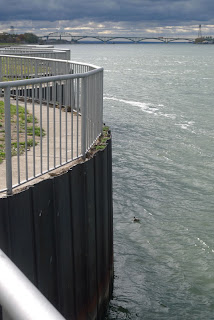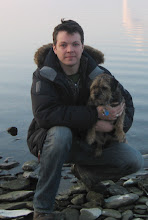
As I've said before, a Big Year is more driving than birding, and that has certainly been true this week. Sometimes all that road time pays off, though, and the past weekend was one of those times. On Saturday I was out with Peter Dorosh, who was leading a trip to the Pennsylvania Avenue Landfill in Brooklyn. This landfill has been capped, and is in the process of being converted into a park. They've covered the top of the 40mil barrier that covers the trash heap with soil, and planted grasses and trees. These are starting to take hold, and it seems very promising as a new bird habitat for Brookyln. We had just spent time IDing a perched Broad Winged hawk when I checked my email and saw that Tom Johnson, Shawn Billerman and others had seen both Pacific Loon and California Gull on Lake Cayuga. I started doing the now very familiar calculations in my head...sunset at 6:15, daylight savings tonight, 4 1/2 hour drive there, need to stop home first for monkey, girlfriend's patience being tested...OK, it looked possible. I said goodbye to the group and was headed back upstate.
I got to Aurora around 4pm and went straight for the California Gull. Shawn had been very helpful on the phone, so I had a good idea of where to look, a gravel spit at the mouth of a stream that empties into Lake Cayuga. There were around 150 gulls on the spit, and many more Canada Geese around them. The Canadas can be a pain in the butt in a situation like this...they are nature's alarm system, and I wasn't able to get closer than 100 yards before they started to call out their warning honks. I was forced to scope from a distance, and it wasn't long before many of the gulls started to fly up and leave, no doubt to roost for the night, probably out in middle of the lake. My fantasy of driving up, seeing both birds, and driving back dissappeared with the gulls, so I went to Long Point park, just a few minutes away, to scope for the Pacific Loon.

As some of you may recall, the Pacific Loon has been a nemesis bird for me this year...I put in about fifty hours of birding last winter staring out over that cold lake in mid-winter, straining to see something other than the Common Loons. I can say from experience that if there is chop on the lake, or if the birds are feeding (by diving underwater) or distant, your chances of finding this bird are slim. Tonight, though, the conditions were good...smooth water, not too cold, and there were a number of Common Loons around. But, no Pacific. So when it got dark I went into Ithica, had dinner at my favorite New Orleans inspired restaurant, and then came back and slept in my car at Long Point. The next morning I was up before first light, and on the shore with my gear as the sun came up. There were considerably more loons now, and I methodically worked my way through them. Pacific Loon is definitely different from Common, but it's not blatant, and the distance and fog can make ID-ing a little tricky. Lucky for me the birds were moving towards shore, and sure enough there was a smaller bodied, smaller billed, rounder-headed bird among them...Pacific Loon. I got a number of photos, and later I went back to them several times, only half-believing that I'd finally seen this bird which had been akin to the Loch Ness Monster earlier in the year.
Heartened by my success with the loon, I went for the gull. There still weren't a lot of gulls on the spit around 8am, and I spent an hour there before deciding to wait a bit and come back. I got a quick breakfast, and also checked around some of the local farmer's fields where I'd seen gulls the night before. I came back around 10 or 11, and now things were looking better...the flock size had tripled, and gulls were continuing to fly in. I'd seen this with the Slaty Backed Gull earlier in the year on Cayuga, where the gulls seemed to follow a predicable schedule...they'd be on the lake until 8 or 8:30, then fly to the compost heaps a few miles away to feed, and then return to the lake later in the day. Likewise, the California Gull had been spotted around 10:30 the previous day, and so it made sense to come back around the same time.

There were now a number of people with their scopes out searching for the gull. It's not an easy bird to pull out of a crowd, and it was probably and hour before I finally happend on a bird, slightly smaller than a Herring Gull, with black and red marks on its bill, slightly darker mantle, yellow legs and ... could it be? ... yes! all black eye. California Gull. After going through this painstaking process, I was triply impressed by Tom Johnson's initial sighting of this bird...I mean, we KNEW that the bird was probably there, and it still took a number of us a long time to find it. Tom didn't know before he saw it that it was even there. I found it inspirational to know that those kinds of skills are possible--I figure just a few thousand hours of study and field time and I'll be there!

The two target birds seen, I could now relax a bit and do some birding. I stopped at the Cornell Lab of O (rnithology) to look for a Red-Shouldered Hawk that is sometimes resident. It hadn't been reported recently, so I got some nice shots of the birds at the feeders, and walked around a bit. It feels good just to be at this spot, one of the centers for birding knowledge and study in the US. After I'd absorbed some of that good energy, I walked back out to my car. I was just getting in when I looked up and saw a circling hawk...not a red tail...not a broad winged...red shouldered! I got a lot of photos (I needed a better photo for this bird), and then got in the car and headed off. Sometimes--not everytime, not even often, but sometimes--everything just goes your way.
 zen eight hour trips upstate to see that newly found bird, to sleep in the car in a parking lot in order to be at the "right place" at sunrise, and to spend a year of your life in non-stop pursuit, whenever and wherever it takes you. Checklisting is the little evil for the greater good. Because in fact what turned out to be truly valuable this year was all the in-between moments...the hours spent with Shai studying terns while waiting for a rare one to appear, the "unproductive" walks in Massawepie Bog for the (never seen) Spruce Grouse, the long but always too-short summer days spent checking the inlets of Long Island, and the hundreds of conversations and encounters with all the passionate birders of this great state.
zen eight hour trips upstate to see that newly found bird, to sleep in the car in a parking lot in order to be at the "right place" at sunrise, and to spend a year of your life in non-stop pursuit, whenever and wherever it takes you. Checklisting is the little evil for the greater good. Because in fact what turned out to be truly valuable this year was all the in-between moments...the hours spent with Shai studying terns while waiting for a rare one to appear, the "unproductive" walks in Massawepie Bog for the (never seen) Spruce Grouse, the long but always too-short summer days spent checking the inlets of Long Island, and the hundreds of conversations and encounters with all the passionate birders of this great state. On New Years Eve I went for a walk with Mary Eyster in Prospect Park, where I began birding, and we had a nearly perfect day. It was crisp and clear, and we had some beautiful birds. A gorgeuous male Purple Finch came into a call and perched a few feet away. The feeders had a festive congregation of doves, red wing blackbirds, nuthatches, Fox Sparrows and woodpeckers. A flock of Robins moved from one tree to the next, and called the alarm as a powerful Red-Tailed Hawk came soaring in throught the trees. There was no chasing here...just a walk in the park, with birds. And that's how I hope to spend many more days as this bright new year unfolds.
On New Years Eve I went for a walk with Mary Eyster in Prospect Park, where I began birding, and we had a nearly perfect day. It was crisp and clear, and we had some beautiful birds. A gorgeuous male Purple Finch came into a call and perched a few feet away. The feeders had a festive congregation of doves, red wing blackbirds, nuthatches, Fox Sparrows and woodpeckers. A flock of Robins moved from one tree to the next, and called the alarm as a powerful Red-Tailed Hawk came soaring in throught the trees. There was no chasing here...just a walk in the park, with birds. And that's how I hope to spend many more days as this bright new year unfolds.


















































